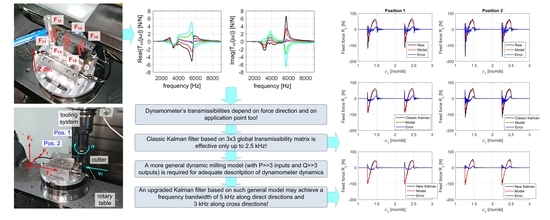Upgraded Kalman Filtering of Cutting Forces in Milling
Abstract
:1. Introduction
- sensitivity issues such as those affecting dynamometers based on strain gauges [5], capacitance sensors [6], optical sensors [7,8,9] and other sensors requiring large structural deformations at the inspected point in order to achieve a satisfactory signal to noise ratio; this is typically obtained by weakening the machining system, thus reducing the resonance frequency;
- load effects such as those introduced by rotating dynamometers [10,11] that may drastically reduce the first resonance frequency of the machine tool spindle (below 500 Hz) with respect to the unaltered configuration where no sensor (thus neither additional modal mass nor additional flexibility) is integrated into the machining system; and
- dynamic inertial disturbances deriving from the undesired but unavoidable oscillations of the modal mass placed in front of the piezoelectric load cells in case of plateform dynamometers; by so doing, even low-frequency vibration modes of the machine tool table where the dynamometer is clamped may cause undesired force fluctuations that cannot be avoided, as explained in [12].
- by improving the device hardware, i.e., by selecting sensors and electromechanical components having higher performances;
- by applying advanced filtering techniques to the measured signals, which may considerably extend the frequency bandwidth above the structural limits [16].
2. Experimental Investigation on Dynamometer Dynamics
2.1. Experimental Setup
2.2. Preliminary Results from Modal Analysis
3. The Upgraded Augmented Kalman Filter (UAKF)
- Experimental modal analysis by means of pulse testing was carried out. The input hammer signal and outputs were obtained from each measurement.
- nonparametric, empirical TFRFs , coherence functions (), and sampled Empirical Impulse Response Estimates (EIREs) with were extracted from the experimental modal analysis data.
- All the EIREs were assembled into the matrixthat has rows and P columns, as each is a column vector. The Singular Value Decomposition was applied to in order to extract the most significant principal components carrying more than 99% of the information contained into . This allowed a considerable matrix compression that boosted the subsequent calculation.
- The discrete Green (Hankel) matrix and the velocity related retarded Green matrix were assembled from the compressed EIREs matrix according to the work in [29] based on the impulse dynamic subspace (IDS) approach. The Singular Value Decomposition was applied this time to and . By a proper multiplication of the obtained principal components the natural pulsations and the damping ratios of the most important vibration modes were obtained. In the current case, it was necessary to include vibration modes in order to achieve a satisfactory mathematical interpolation (though probably some modes were mostly mathematical artifacts rather than physical modes). The natural frequencies and damping factors were used to construct the state space matrix as follows,where and are null and identity matrices of size .
- Each was then expressed as the sumwhere the static gains were associated to elastic force contributions due to device deformation, whereas were associated to viscous damping forces that are proportional to the modal velocities. These coefficients were determined by stepwise linear regression and weighted linear regression procedures that were carried out in the frequency domain. As a result, a total of modal parameters have been determined so far. This would have implied a very large state space vector of size , that would have caused numerical issues if not properly handled. A considerable dimension reduction was then achieved by noting that the P column vectors composing the matrices and (for any fixed m) had to be all proportional to the same eigenmode shape inspected at the available outputs. The constants of proportionality were expected to be in general different from each other since they corresponded to the participation factors associated to each of the P inputs. However, the two matrices and had to be rank-one matrices. In other words, their first principal component obtained from SVD should have provided a good approximation of their structure, as follows,and similarly forThus, only the modes satisfying this approximation were kept in the final model.
- Then, the matrix could be assembled as follows,whereas matrix was written as follows,Matrix was of size , while matrix was of size . Accordingly, the global state space matrix had to be doubled, i.e.,Thus, the associated state space vector was of size , which was still large but less problematic. In detail, the final state space vector size was in the range instead of .
- In order to improve the global model adequacy, the coefficients of the matrix were recalculated by means of another (weighted) linear regression procedure that was carried out in the frequency domain, by exploiting the relation
- The obtained dynamic system may be used for accurately estimating the measured outputs from known inputs. Nevertheless, here we were interested in the inverse problem: estimating all the inputs from the outputs. This is in general not possible when two or more distinct inputs generate very similar outputs. In order to extract the maximum amount of information regarding the input structure, the Singular Value Decomposition was applied on matrix , thus yieldingwhere denotes a reduced form including only the most important principal components. In the current approximation, principal components were sufficient to represent ~99% of the information contained in . Thus, the final state space form washaving “orthogonal” inputs producing distinguishable outputs, whence they could be reconstructed by applying the Kalman filter. This was a key step in order to obtain a successful filter.
- The Upgraded Augmented Kalman Filter was obtained from the expanded state space form aswhere the input force was incorporated into an expanded state space vector , and it was artificially generated as the integral of a Gaussian process noise of size . A Gaussian measurement noise of size was also added to the output. and were null and identity matrices of adequate sizes.
- Process and measurement noises were described by the covariance matriceswhere the covariances’ orders of magnitude were selected after a preliminary trial and error phase.
- A stationary Kalman filter was eventually determined as follows,where the observer (obs) gain matrix was computed by the classical lqe Matlab routine. Finally, the inverse PCA transformation matrix was applied in order to reconstruct the input force vector, as follows,and therefore the resultant force components could be derived by applying Equation (1). It is worth noting that the Upgraded Augmented Kalman Filter (UAKF) proposed here is practically a classic Augmented Kalman Filter based on a much more general model of dynamometer dynamics.
4. Filter Performance Evaluation
4.1. Comparison with Hammer Signal during Pulse Tests
- raw average cutting forces obtained from the static calibration phase, see Equation (2);
- a state-of-the-art Augmented Kalman Filter that was only based on the direct TFRFs , and of the global transmissibility matrix defined by Equation (4);
- a slightly more advanced Augmented Kalman Filter that was based on the complete transmissibility matrix of Equation (4), including cross TFRFs; and
- the novel Upgraded Augmented Kalman Filter based on the complete model of dynamometer dynamics.
- when considering the direct TFRFs the usable frequency bandwidth corresponds to the frequency where the TFRF amplitude exits the dB thresholds or the coherence function decreases below 80%;
- when considering cross TFRFs, the frequency bandwidth corresponds to the frequency where the upper confidence limit of the estimated cross TFRF exceeds 20%.
4.2. Comparison with Cutting Force Model during Real Cutting Tests
5. Conclusions
Author Contributions
Funding
Acknowledgments
Conflicts of Interest
Abbreviations
| AKF | Augmented Kalman Filter (classic from state of the art) |
| UAKF | Upgraded Augmented Kalman Filter (novel proposed here) |
| SVD | Singular Value Decomposition |
| PCA | Principal Component Analysis |
| TFRF | Transmissibility Frequency Response Function |
| EIRE | Empirical Impulse Response Estimate |
| generic input force along a given direction and at a precise location | |
| P | total number of different input forces applied during modal testing |
| component of the resultant input force, with | |
| generic output signal from the dynamometer | |
| Q | total number of dynamometer output signals |
| component of the resultant force derived from dynamometer, with | |
| global transmissibility between and | |
| transmissibility between and | |
| total number of output signals including the 3 estimated resultant components | |
| Empirical Impulse Response Estimate corresponding to | |
| N | length of each vector |
| number of most important principal components representing input information | |
| M | total number of vibration modes representing dynamometer dynamics |
| static gain corr. to vibration mode m and to caused by device deformation | |
| static gain corr. to vibration mode m and to caused by viscous damping forces | |
| natural pulsation of the vibration mode | |
| damping ratio of the vibration mode | |
| , and | state space matrices representing full dynamometer dynamics |
| state space vector representing full dynamometer dynamics | |
| matrix after PCA transformation | |
| input force vector after PCA transformation | |
| number of most important principal components representing input information | |
| , and | matrices of the expanded state space form |
| expanded state space vector | |
| process noise | |
| measurement noise | |
| observer gain matrix | |
| observed (expanded) state space vector |
References
- Sousa, V.; Silva, F.; Fecheira, J.; Lopes, H.; Martinho, L.; Casais, R.; Ferreira, L. Cutting Forces Assessment in CNC Machining Processes: A Critical Review. Sensors 2020, 20, 4536. [Google Scholar] [CrossRef] [PubMed]
- Wang, C.-P.; Erkorkmaz, K.; McPhee, J.; Engin, S. In-process digital twin estimation for high-performance machine toolswith coupled multibody dynamics. CIRP Ann. Manuf. Technol. 2020, 69, 321–324. [Google Scholar] [CrossRef]
- Jun, M.; Ozdoganlar, O.; DeVor, R.; Kapoor, S.; Kirchheim, A.; Schaffner, G. Evaluation of a spindle-based force sensor for monitoring and fault diagnosis of machining operations. Int. J. Mach. Tools Manuf. 2002, 42, 741–751. [Google Scholar] [CrossRef]
- Klocke, F.; Blattner, M.; Adams, O.; Brockmann, M.; Veselovac, D. Compensation of Disturbances on Force Signals for Five-Axis Milling Processes. Procedia CIRP 2014, 14, 472–477. [Google Scholar] [CrossRef] [Green Version]
- Yaldiz, S.; Unsacar, F.; Saglam, H.; Isik, H. Design, development and testing of a four-component milling dynamometer for the measurement of cutting force and torque. Mech. Syst. Signal Process. 2007, 21, 1499–1511. [Google Scholar] [CrossRef]
- Gomez, M.; Schmitz, T. Displacement-based dynamometer for milling force measurement. Procedia Manuf. 2019, 34, 867–875. [Google Scholar] [CrossRef]
- Subasi, O.; Yazgi, S.; Lazoglu, I. A novel triaxial optoelectronic based dynamometer for machining processes. Sens. Actuators A Phys. 2018, 279, 168–177. [Google Scholar] [CrossRef]
- Sandwell, A.; Lee, J.; Park, C.; Park, S. Novel multi-degrees of freedom optical table dynamometer for force measurements. Sens. Actuators A Phys. 2020, 303, 111688. [Google Scholar] [CrossRef]
- Gomez, M.; Schmitz, T. Low-cost, constrained-motion dynamometer for milling forcemeasurement. Manuf. Lett. 2020, 25, 34–39. [Google Scholar] [CrossRef]
- Rizal, M.; Ghani, J.; Nuawi, M.; Hassan, C.; Haron, C. Development and testing of an integrated rotating dynamometer on tool holder for milling process. Mech. Syst. Signal Process. 2015, 52–53, 559–576. [Google Scholar] [CrossRef]
- Xie, Z.; Lu, Y.; Li, J. Development and testing of an integrated smart tool holder for four-component cutting force measurement. Mech. Syst. Signal Process. 2017, 93, 225–240. [Google Scholar] [CrossRef]
- Totis, G.; Adams, O.; Sortino, M.; Veselovac, D.; Klocke, F. Development of an innovative plate dynamometer for advanced milling and drilling applications. Measurement 2014, 49, 164–181. [Google Scholar] [CrossRef]
- Totis, G.; Sortino, M. Development of a modular dynamometer for triaxial cutting force measurement in turning. Int. J. Mach. Tools Manuf. 2011, 51, 34–42. [Google Scholar] [CrossRef]
- Totis, G.; Wirtz, G.; Sortino, M.; Veselovac, D.; Kuljanic, E.; Klocke, F. Development of a dynamometer for measuring individual cutting edge forces in face milling. Mech. Syst. Signal Process. 2010, 24, 1844–1857. [Google Scholar] [CrossRef]
- Luo, M.; Luo, H.; Axinte, D.; Liu, D.; Mei, J.; Liao, Z. A wireless instrumented milling cutter system with embedded PVDF sensors. Mech. Syst. Signal Process. 2018, 110, 556–568. [Google Scholar] [CrossRef] [Green Version]
- Korkmaz, E.; Gozen, B.A.; Bediz, B.; Ozdoganlar, O.B. Accurate measurement of micromachining forces through dynamic compensation of dynamometers. Precis. Eng. 2017, 49, 365–376. [Google Scholar] [CrossRef]
- Rezvani, S.; Nikolov, N.; Kim, C.; Park, S.; Lee, J. Development of a Vise with built-in Piezoelectric and Strain Gauge Sensors for Clamping and Cutting Force Measurements. Procedia Manuf. 2020, 48, 1041–1046. [Google Scholar] [CrossRef]
- Luo, M.; Chong, Z.; Liu, D. Cutting Forces Measurement for Milling Process by Using Working Tables with Integrated PVDF Thin-Film Sensors. Sensors 2018, 18, 4031. [Google Scholar] [CrossRef] [Green Version]
- Castro, L.R.; Vieville, P.; Lipinski, P. Correction of dynamic effects on force measurements made with piezoelectric dynamometers. Int. J. Mach. Tools Manuf. 2006, 46, 1707–1715. [Google Scholar] [CrossRef]
- Girardin, F.; Remond, D.; Rigal, J.F. High Frequency Correction of Dynamometer for Cutting Force Observation in Milling. J. Manuf. Sci. Eng. 2010, 132, 031002. [Google Scholar] [CrossRef]
- Wan, M.; Yin, W.; Zhang, W.-H.; Liu, H. Improved inverse filter for the correction of distorted measured cutting forces. Int. J. Mech. Sci. 2017, 120, 276–285. [Google Scholar] [CrossRef]
- Kiran, K.; Kayacan, M.C. Cutting force modeling and accurate measurement in milling of flexible workpieces. Mech. Syst. Signal Process. 2019, 133, 106284. [Google Scholar] [CrossRef]
- Korkmaz, E.; Bediz, B.; Gozen, B.A.; Ozdoganlar, O.B. Dynamic characterization of multi-axis dynamometers. Precis. Eng. 2014, 38, 148–161. [Google Scholar] [CrossRef]
- Albrecht, A.; Park, S.S.; Altintas, Y.; Pritschow, G. High frequency bandwidth cutting force measurement in milling using capacitance displacement sensors. Int. J. Mach. Tools Manuf. 2005, 45, 993–1008. [Google Scholar] [CrossRef]
- Chae, J.; Park, S.S. High frequency bandwidth measurements of micro cutting forces. Int. J. Mach. Tools Manuf. 2007, 47, 1433–1441. [Google Scholar] [CrossRef]
- Scippa, A.; Sallese, L.; Grossi, N.; Campatelli, G. Improved dynamic compensation for accurate cutting force measurements in milling applications. Mech. Syst. Signal Process. 2015, 54–55, 314–324. [Google Scholar] [CrossRef]
- Jullien-Corrigan, A.; Ahmadi, K. Measurement of high-frequency milling forces using piezoelectric dynamometers with dynamic compensation. Precis. Eng. 2020, 66, 1–9. [Google Scholar] [CrossRef]
- Wang, C.; Qiao, B.; Zhang, X.; Cao, H.; Chen, X. TPA and RCSA based frequency response function modelling for cutting forces compensation. J. Sound Vib. 2019, 456, 272–288. [Google Scholar] [CrossRef]
- Dombovari, Z. Dominant modal decomposition method. J. Sound Vib. 2017, 392, 56–69. [Google Scholar] [CrossRef]
- Totis, G.; Albertelli, P.; Torta, M.; Sortino, M.; Monno, M. Upgraded stability analysis of milling operations by means of advanced modeling of tooling system bending. Int. J. Mach. Tools Manuf. 2017, 113, 19–34. [Google Scholar] [CrossRef]
- Totis, G. Breakthrough of regenerative chatter modeling in milling by including unexpected effects arising from tooling system deflection. Int. J. Adv. Manuf. Technol. 2017, 89, 2515–2534. [Google Scholar] [CrossRef]
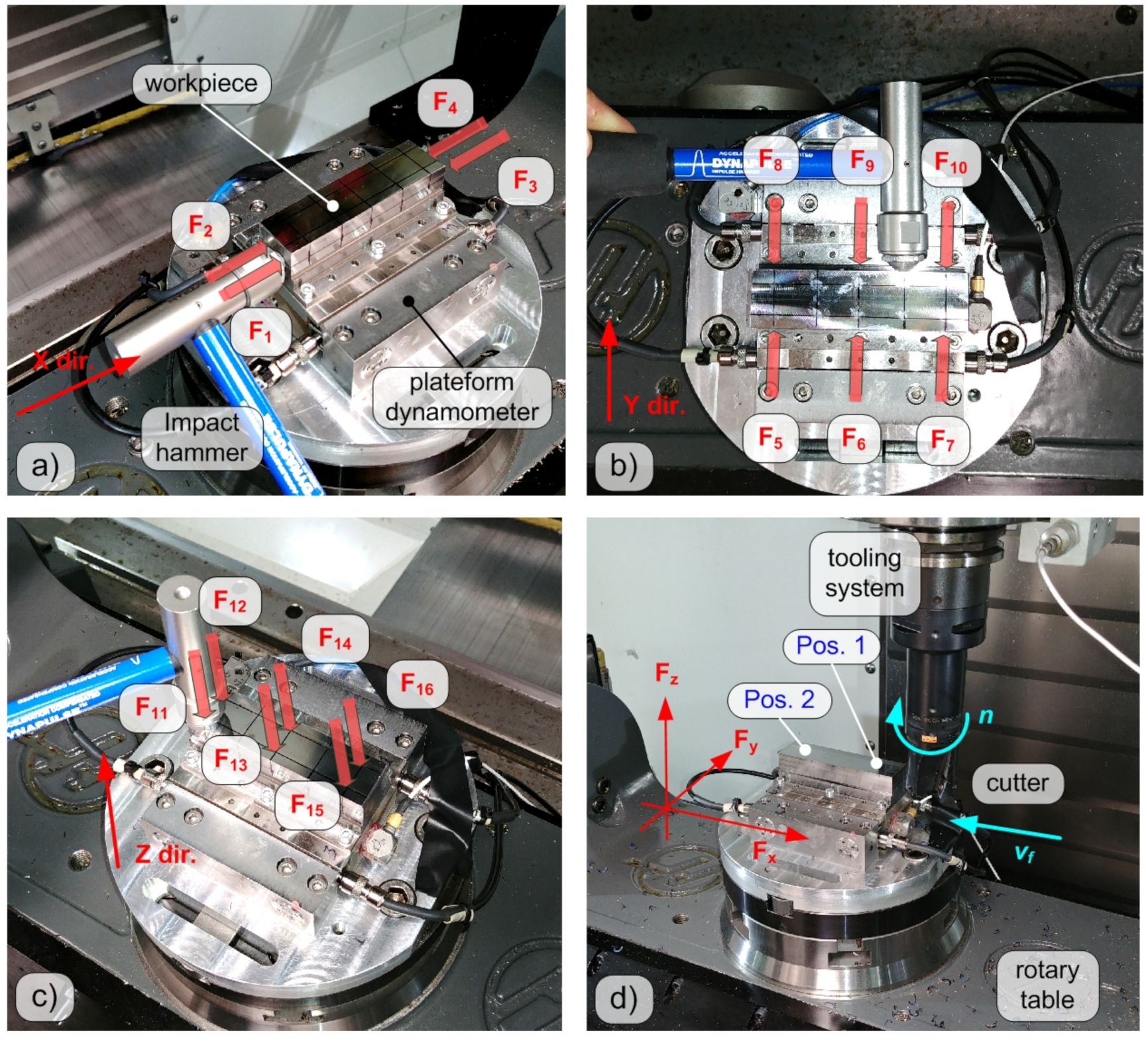
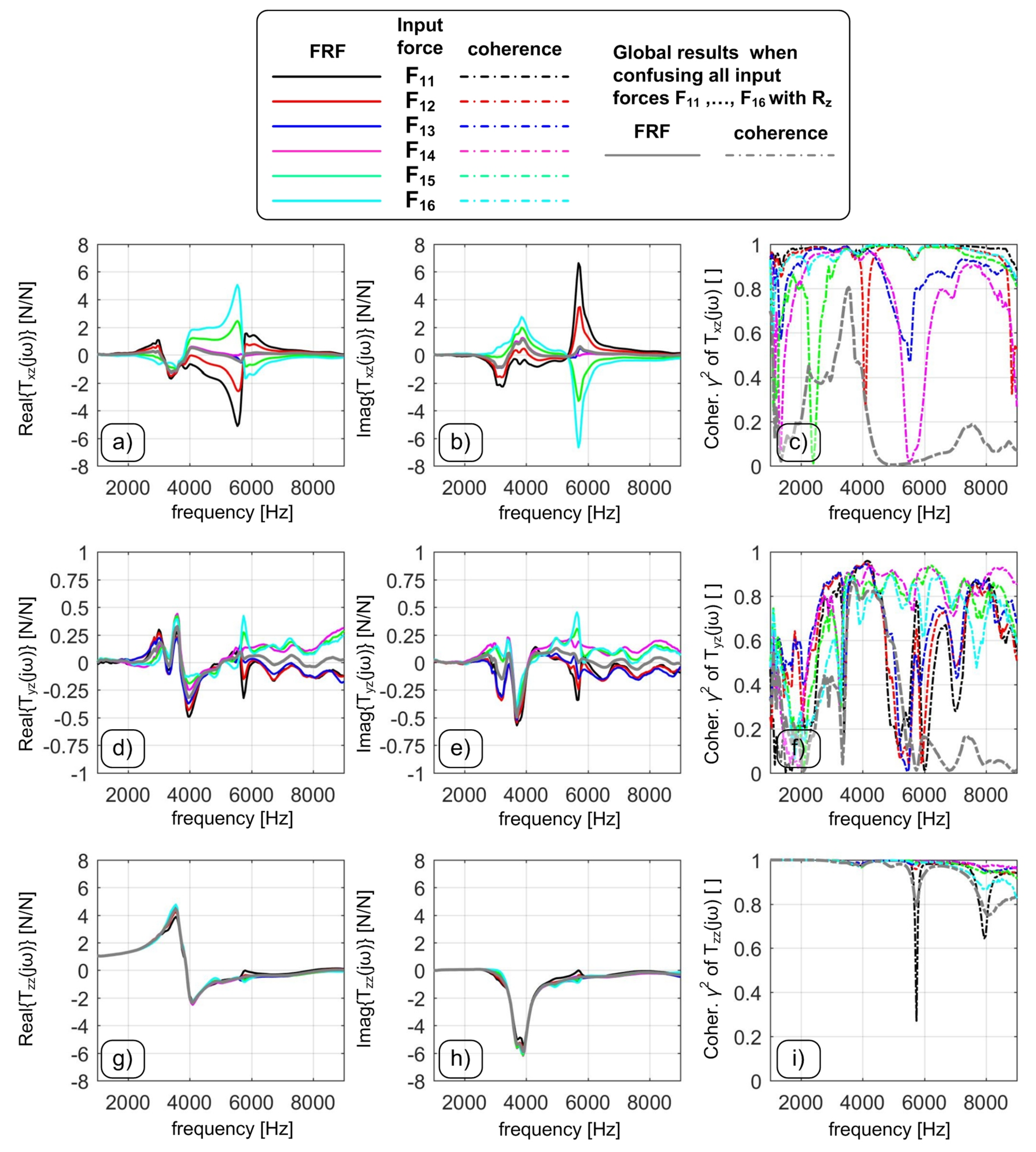
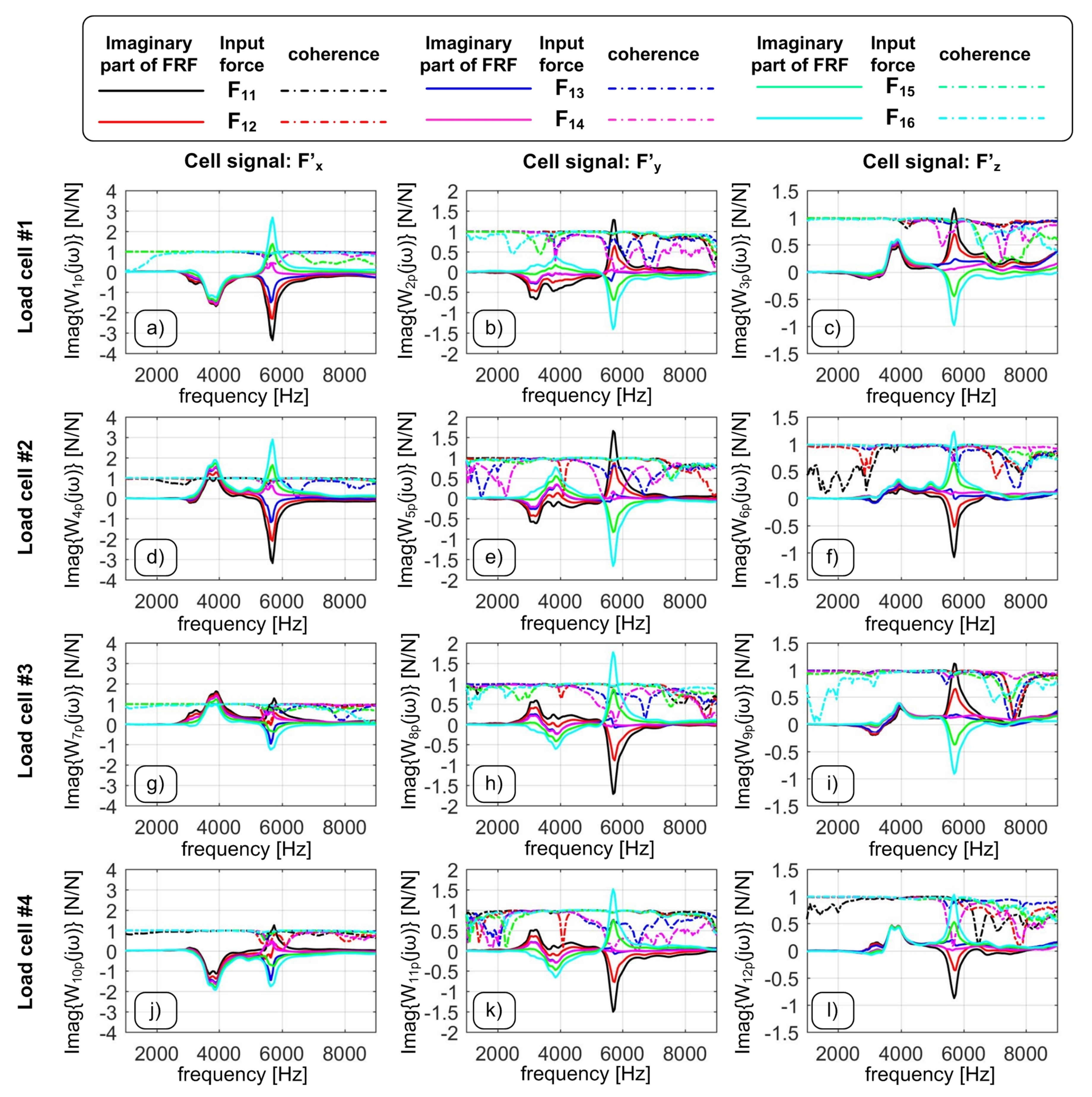
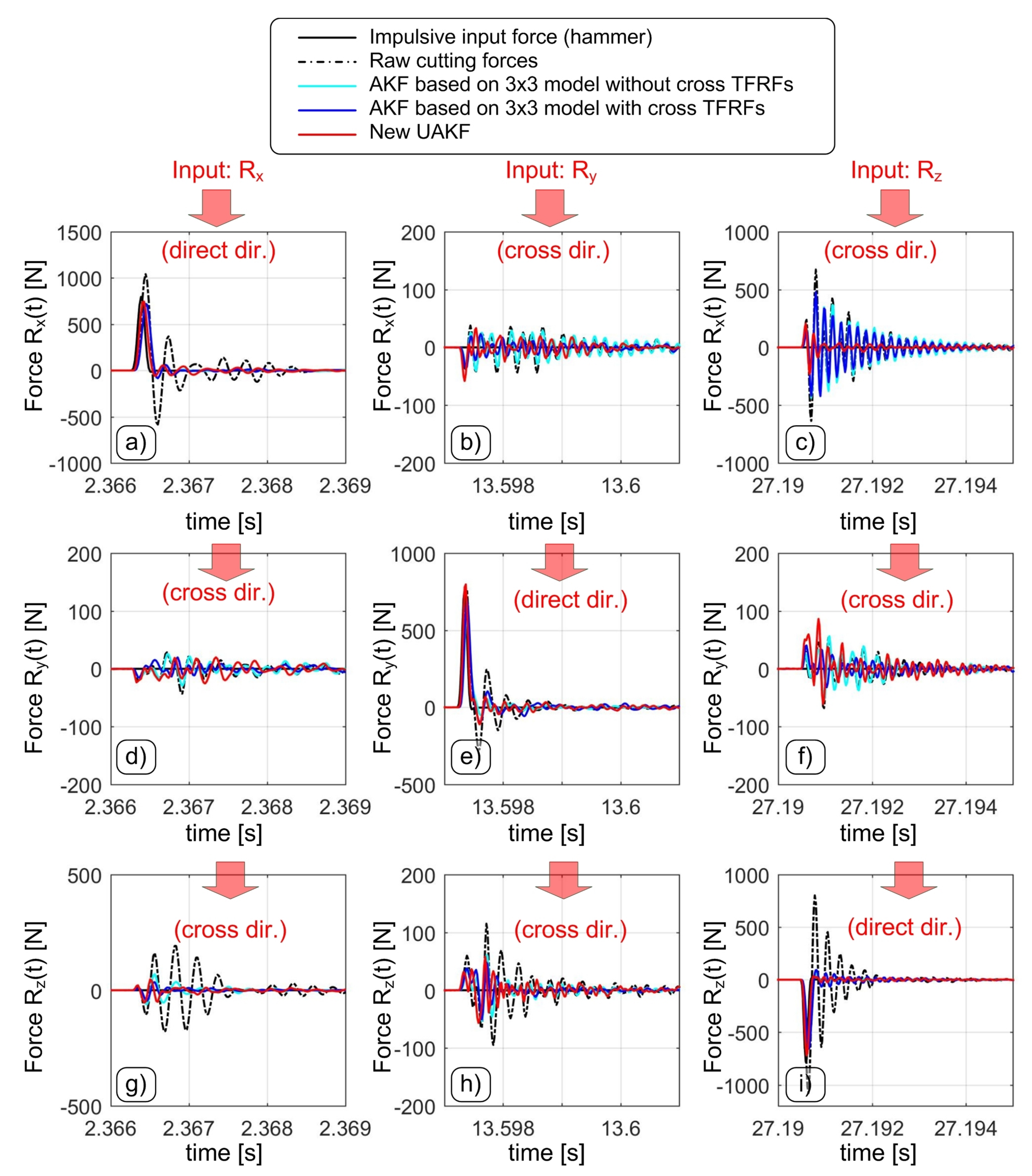

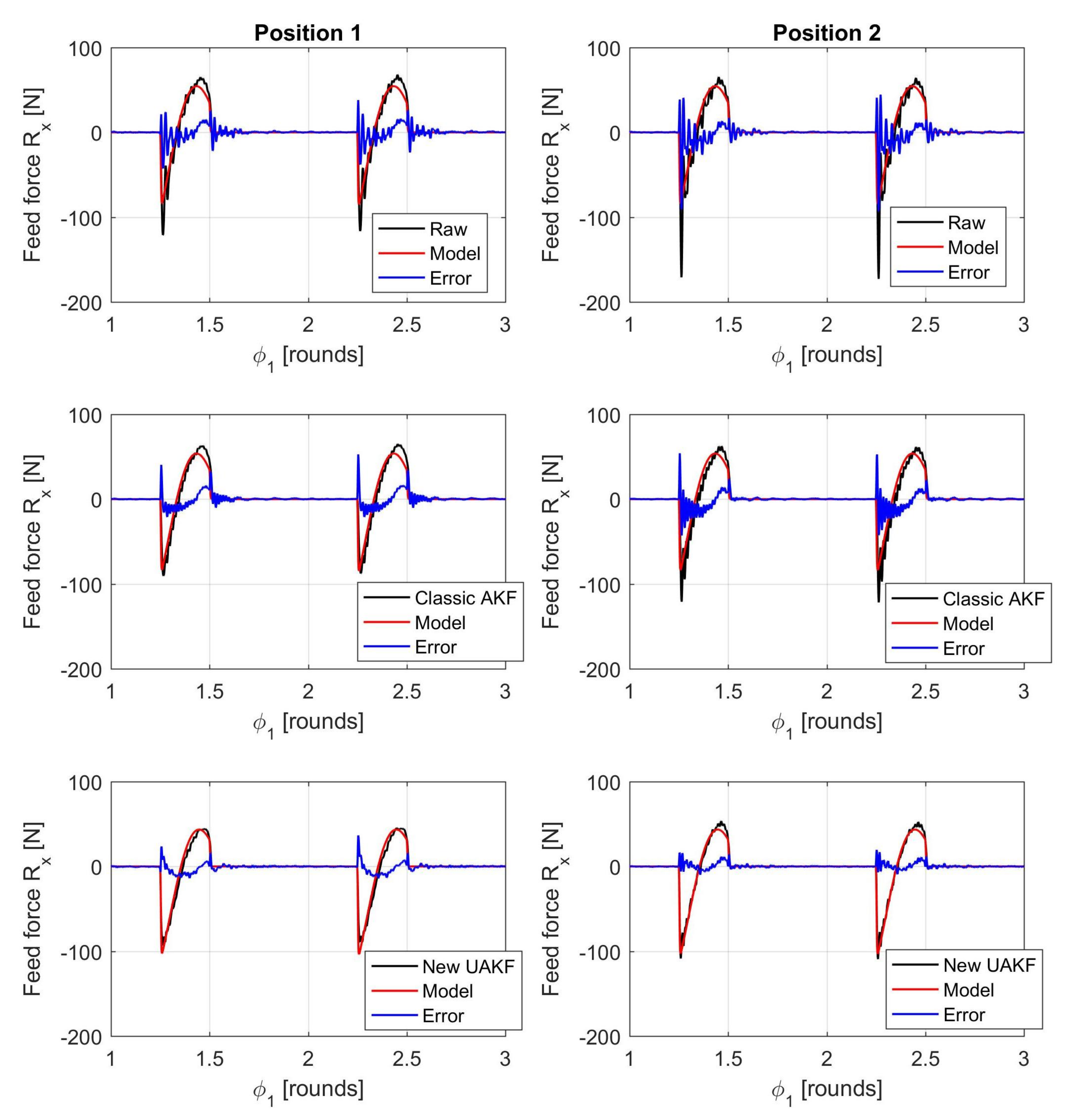
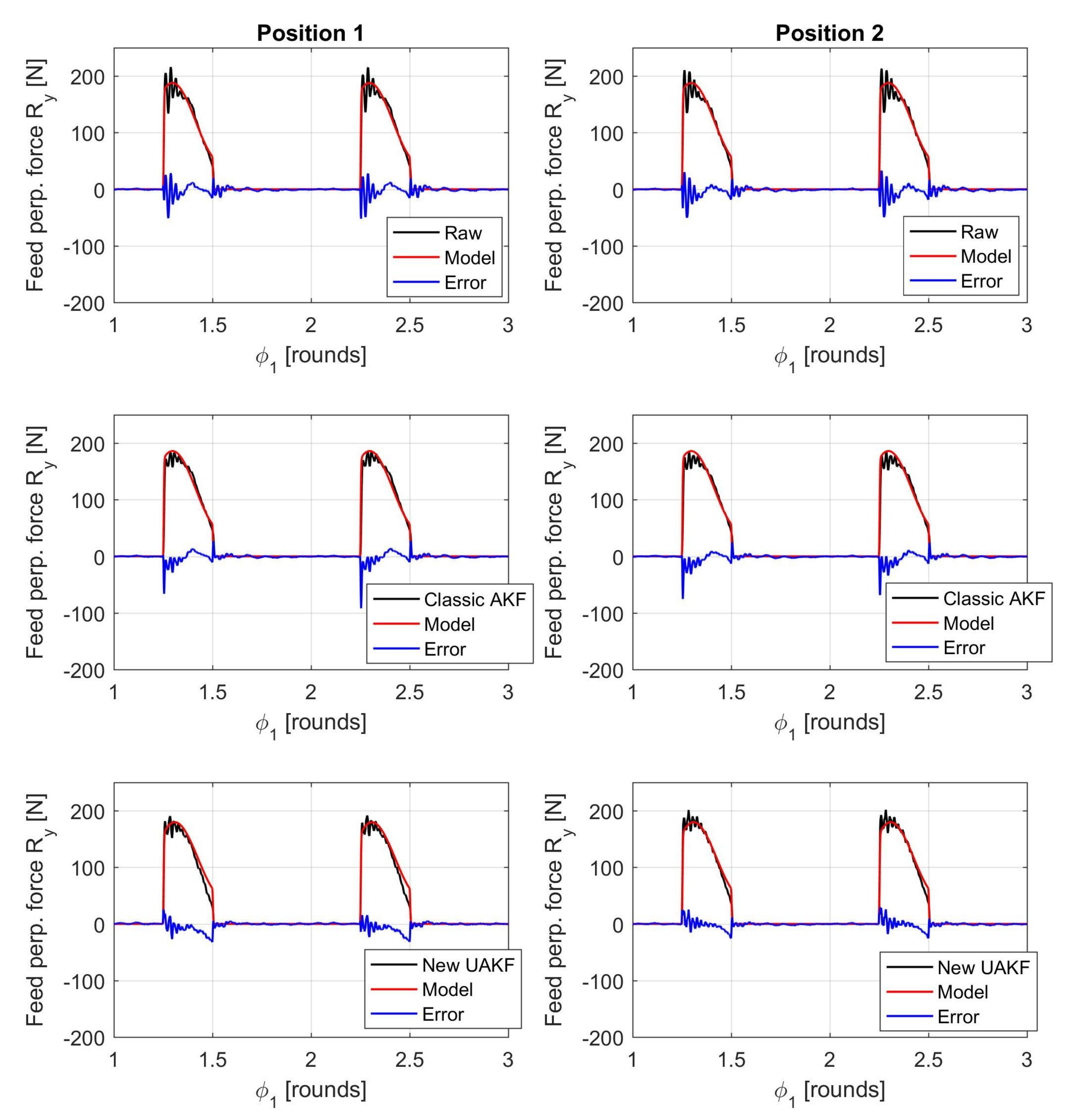

| Filter | |||||||||
|---|---|---|---|---|---|---|---|---|---|
| Aver. res. components from Equation (2) | 2.27 | 2.27 | 2.20 | 2.49 | 2.26 | 2.65 | 2.70 | 2.44 | 2.6 |
| AKF without cross terms | 4.90 | 4.05 | 5.40 | 4.65 | 2.37 | 3.50 | 3.40 | 2.80 | 5.10 |
| AKF with cross terms | 4.90 | 4.05 | 5.40 | 3.46 | 2.52 | 3.60 | 3.30 | 9.20 | 5.10 |
| New UAKF | 5.10 | 5.40 * | 7.80 | 4.75 | 3.32 | 3.31 | 3.35 | 5.15 | 4.95 |
| Filter | [%] | [%] | [%] | [%] | [%] | [%] | |||
|---|---|---|---|---|---|---|---|---|---|
| Aver. res. components from Equation (2) | 0.411 | 0.755 | 0.423 | 19 | 85 | 12 | 16 | 45 | 24 |
| AKF without cross terms | 0.466 | 0.764 | 0.867 | 13 | 68 | 9 | 15 | 12 | 9 |
| AKF with cross terms | 0.523 | 0.723 | 0.872 | 9 | 60 | 7 | 9 | 6 | 8 |
| New UAKF | 0.868 | 0.835 | 0.873 | 10 | 19 | 9 | 12 | 9 | 9 |
| Filter | [%] | [%] | [%] | |||
|---|---|---|---|---|---|---|
| Aver. res. components from Equation (2) | 0.896 | 0.979 | 0.960 | 8.5 | 4.0 | 5.7 |
| Kalman without cross terms | 0.892 | 0.980 | 0.974 | 9.4 | 3.9 | 5.3 |
| Kalman with cross terms | 0.913 | 0.980 | 0.973 | 7.3 | 3.9 | 5.0 |
| New upgraded Kalman filter | 0.966 | 0.984 | 0.972 | 3.3 | 3.7 | 4.6 |
© 2020 by the authors. Licensee MDPI, Basel, Switzerland. This article is an open access article distributed under the terms and conditions of the Creative Commons Attribution (CC BY) license (http://creativecommons.org/licenses/by/4.0/).
Share and Cite
Totis, G.; Dombovari, Z.; Sortino, M. Upgraded Kalman Filtering of Cutting Forces in Milling. Sensors 2020, 20, 5397. https://doi.org/10.3390/s20185397
Totis G, Dombovari Z, Sortino M. Upgraded Kalman Filtering of Cutting Forces in Milling. Sensors. 2020; 20(18):5397. https://doi.org/10.3390/s20185397
Chicago/Turabian StyleTotis, Giovanni, Zoltan Dombovari, and Marco Sortino. 2020. "Upgraded Kalman Filtering of Cutting Forces in Milling" Sensors 20, no. 18: 5397. https://doi.org/10.3390/s20185397
APA StyleTotis, G., Dombovari, Z., & Sortino, M. (2020). Upgraded Kalman Filtering of Cutting Forces in Milling. Sensors, 20(18), 5397. https://doi.org/10.3390/s20185397





